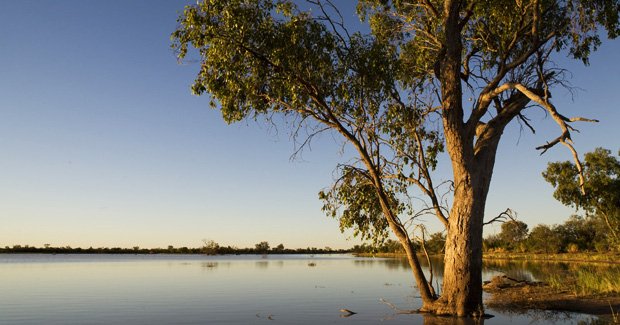Protecting culture and environment along the Murray

IT’S OUR FIRST MORNING on the Murray River project. We have made our way to the road leading into Barmah State Park, a protected area that spans 28,000 hectares along the Murray River, on the Victoria and New South Wales border.
For the next few days our group, led by Conservation Volunteers Australia (CVA), will work around the Dharnya Centre — the park’s interpretation centre. Opened in 1985, the complex comprises is a series of stunning buildings made from the river red gums that surround them. The buildings were closed in 2007 after falling into disrepair from a white ant infestation. Interestingly, only the wood brought in from elsewhere was affected, says Hilda Stewart, a Cultural Interpretation Officer from Parks Victoria. “The ants didn’t touch the red gum or the other wood from around here,” Hilda says, pointing to the giant beams above our heads.
We are shown around the site by Hilda, and Greta Morgan. They are both members of the Yorta Yorta people, whose culture is intertwined with the giant gums and the river.
“A lot of Yorta people worked in forestry,” Hilda tells me. She remembers her father and uncles working in the forest as she played in the river and creeks of the Murray. Now she and Greta have a role to play teaching others about the forests and the people who have called the area home for thousands of years. “It’s all about educating people,” Hilda says. “Making them aware that we still have our beliefs and culture.”
WITH THE ESTABLISHMENT of the new Red Gum National Park being slated for June this year, Hilda and Greta are hopeful that the Dharnya Centre will come into its own again, and I’d like to think it will too. It is a stunning building set in beautiful surrounds that showcase the natural and cultural heritage of the area.
It makes me think; the word conservation brings to mind a group of greenies planting trees and pulling weeds, but here, the CVA is helping restore not only the environment but some of the cultural history of the area as well.
At the end of our first day, I take up the traditional worker’s stance – decked in a yellow vest, dirt-covered jeans and work boots, leaning lazily on a shovel – and survey our work. We have numbered seven people, worked for about seven hours and have cleared paths and laid gravel around the centre’s grounds. I hear Lois Pickering, a perpetual CVA volunteer who has joined us for the week: “It makes you think,” muses Lois. “The people who come here probably don’t even know how hard we worked to get it like this.”
Perhaps the visitors don’t, but we do, and so do Hilda and Greta, and that’s enough for me.
LINKS
Volunteer opportunities for 2010

